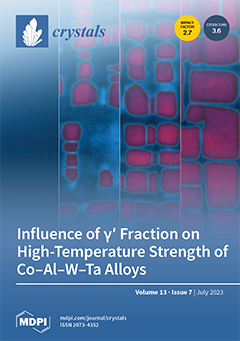With the development of computational thermodynamics, it is possible to design a material based on its simulated microstructure and properties before practical operations. In order to improve the surface properties of AZ91D magnesium alloy, Jmatpro was used in this study to design an
[...] Read more.
With the development of computational thermodynamics, it is possible to design a material based on its simulated microstructure and properties before practical operations. In order to improve the surface properties of AZ91D magnesium alloy, Jmatpro was used in this study to design an alloy system with in situ TiC+AlTi
3-reinforced aluminum coatings. The Gibbs free energy, hardness, and phase diagrams of aluminum coatings with different ratios of Ti to B
4C were simulated. According to the simulation results, TiB
2, TiC, Al
3Ti_DO
22, and Al
4C
3 were formed in the coating while TiB
2, TiC, Al
3Ti_DO
22, Al
4C
3, and Al
3Mg
2 were formed in the transition zone between the base metal and the coating. Based on the simulation results, different amounts of Ti were used with B
4C (the ratios were 3:1, 4:1, 5:1, and 6:1) to fabricate TiC+Al
3Ti reinforced aluminum coatings on AZ91D magnesium alloy via laser cladding. The microstructure and phase composition of the coating were studied using scanning electron microscopy (SEM) incorporated with energy- dispersive spectrometry (EDS) and X-ray diffraction (XRD). The results indicated that intermetallic phases, such as AlTi
3(C, N)
0.6, AlMg, Al
3Mg
2, Al
3Ti, and TiC were formed in the coatings. As the Ti content increased, the content of Al
3Ti increased and the content of TiC decreased in the coatings, which is consistent with the simulation results. The average hardness of the coatings was approximately four to five times that of the magnesium alloy substrate, and the corrosion current density of the coatings was around 2.5 × 10
−6, which is two orders of magnitude lower than that of AZ91D magnesium alloy.
Full article





